http://www.asor.org/anetoday/2020/03/mummification-canary-islands
'Mummify like an Egyptian' – Egyptianizing Mummification in the Canary Islands
By Daniel M. Méndez-Rodríguez
The Canary Islands are a Spanish archipelago composed of eight islands in the Atlantic Ocean in the northwest coast of Africa near Morocco.
 Location of the Canary Islands. (Wikimedia Commons)
Location of the Canary Islands. (Wikimedia Commons)
Before the European conquest, these islands were inhabited by different indigenous groups of people who came – or more probably were carried – in antiquity from the north of Africa in not entirely clear circumstances.
One of the most remarkable features of their culture was the funerary practice of artificial conservation of the bodies.

Best preserved Guanche mummy. Museo Arqueológico Nacional, Madrid. (Photograph by Daniel Méndez-Rodríguez)
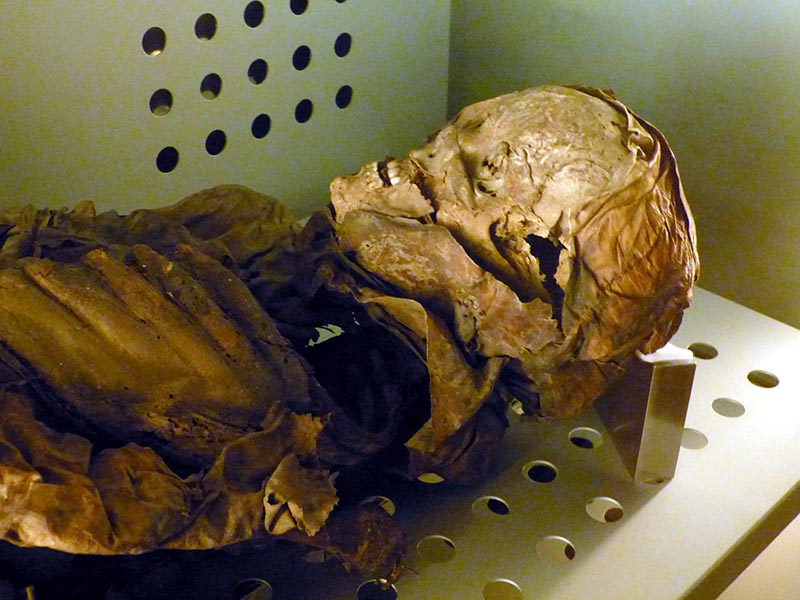
Mummified body. Museo de la Naturaleza y la Arqueología, Tenerife. (Wikimedia Commons)
This kind of mummification in the Canary Islands is usually called mirlado and has been attested in three of the eight islands: Tenerife, Gran Canaria and La Palma. Elements of the practice seem almost Egyptian in terms of objectives and methods, but is there a relationship?
Information about the Canarian mummification comes from two main types of sources. The first is physical anthropology since the end of the 1980s through the 20th century. The second source is accounts by many authors since the 15th century, which provide especially valuable information. Here I focus on the latter, the interest shown by many individuals of different historic contexts and professional backgrounds: priests, astronomers, merchants, explorers, naturalists, doctors, and more. More than seventy authors have written about the mummies from the end of the 15th century to the first half of the 20th century.
Descriptions of the Canarian embalming procedures address many different aspects. The embalmers are described as specialists dedicated exclusively to this activity and included both men and women, with division of labor depending on the sex of the corpse to be treated. They were said to be a separate community of the aboriginal society regarded as outcasts due to their contact with the dead bodies.
Perhaps the most interesting information is related to the different processes of the mirlado or mummification. The accounts specified the place where the procedure was carried out; duration (around 15 or 20 days); different kinds of washing; the corpse preparation, with information about thorax and abdomen evisceration if undertaken; body manipulation with the insertion or the application of different types of substances of animal, vegetal and/or mineral origin (for example: ovicaprid fat, heather, pine tree bark, astringent herbs and pumice stones); different drying processes; and the wrapping, done using different layers of ovicapids skins girded tightly with leather thongs.
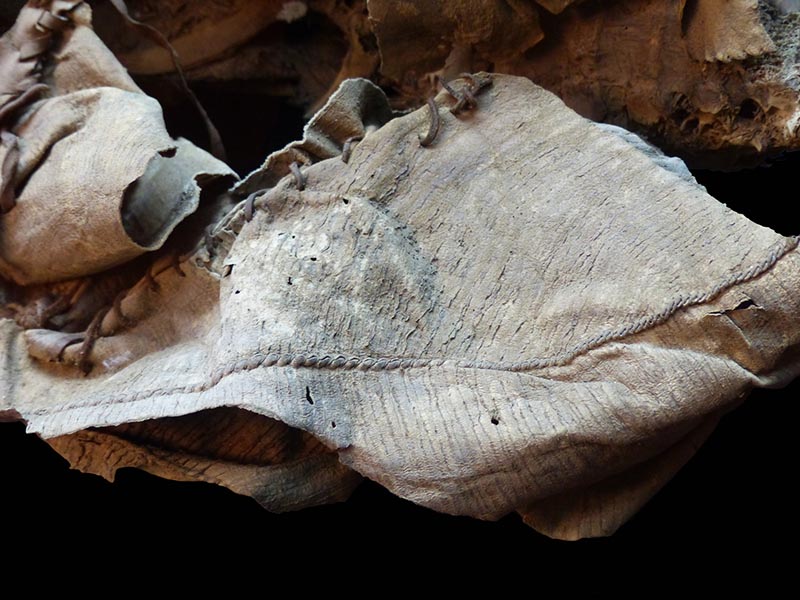
Mummy wrapping made of ovicaprid skin. Museum of the Instituto Canarias Cabrera Pinto. (Photograph by Daniel Mendez-Rodríguez)
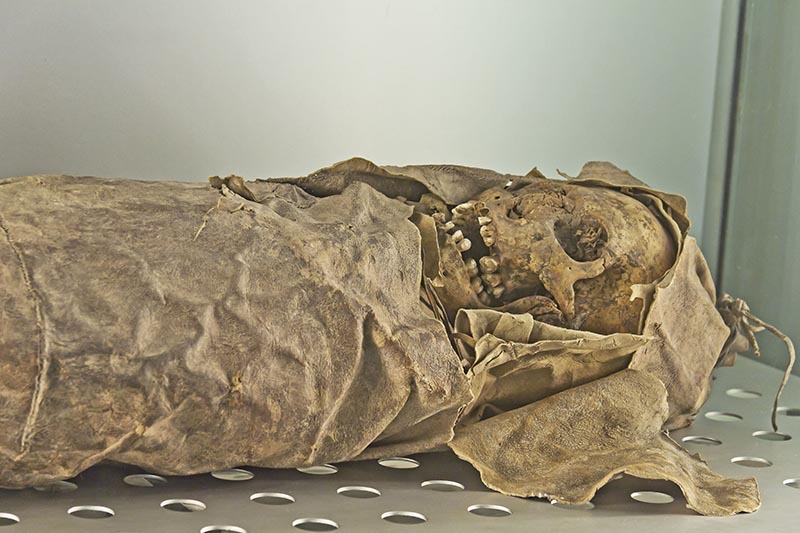
Wrapped skeletal remains. Museo de la Naturaleza y la Arqueología, Tenerife. (Wikimedia Commons)
Different practices related to the social status of the deceased as to the use of coffins or certain funerary equipment are described. Finally, the burial practices, including the use of coffins, the deposit of the corpses and their position (laying down, sitting down or standing up against a wall), and the custom of the bodies orientation to the north in Gran Canaria are also discussed. The final resting place of the deceased was commonly inaccessible caves or, in the case of Gran Canaria, funerary tumuli.
The texts discuss embalming procedures and/or mummies' descriptions. The origin of their information for these texts was diverse: oral data from the aborigines' descendants or peasants (found only exceptionally in the oldest texts, for example Alonso de Espinosa's 1594 account), and also the writers' experience visiting indigenous sites as burial caves.

Alonso de Espinosa publication (1594).
The overwhelming majority of the authors relied on previous accounts, both mentioning and omitting their sources. Texts provided information specifically about the mirlado itself, but also, in order to achieve a comparative view, cited evidence from classical antiquity. These accounts explained the embalming procedures of Egyptian mummification using Herodotus (5th century BCE) and Diodorus Siculus (1st century BCE).
Information transmission while editing texts during centuries involved processes of modification, addition, omission, and (re)elaboration. Comparative materials were added, not based on knowledge about the indigenous Canarians but on information or notions related to the Egyptian mummification or, more generally, Egyptian culture. Thus, certain descriptions about the Canarian mummification have been Egyptianized over the past centuries. This has leaded to misconceptions, some of which has been accepted and transmitted without criticism by scholars even until the present day.
Some of these misconceptions include the consideration of the embalmers as priests, their positive social position and organizational division of labor, the use of salt for desiccation and washing, and probably mention of removal of the brain. This procedure has been called into question since no traces of it has been found in any Canarian embalmed body. Therefore, its presence in the texts may be also due to the comparison with the Egyptian procedures. Spanish priest José de Viera y Clavijo, one of the main figures of the 18th century Enlightenment in the Canary Islands, was the responsible for some of this misconception.
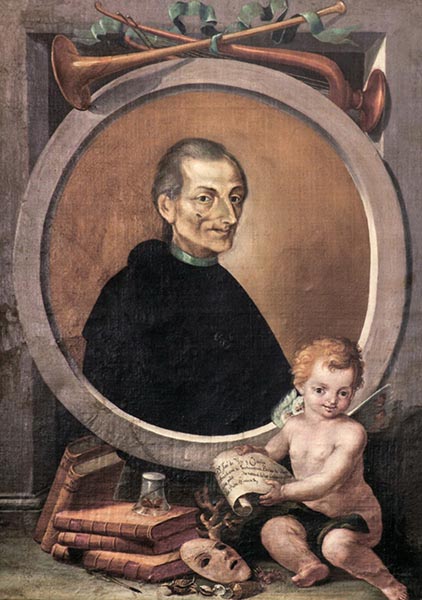
José de Viera y Clavijo. (Wikimedia Commons)
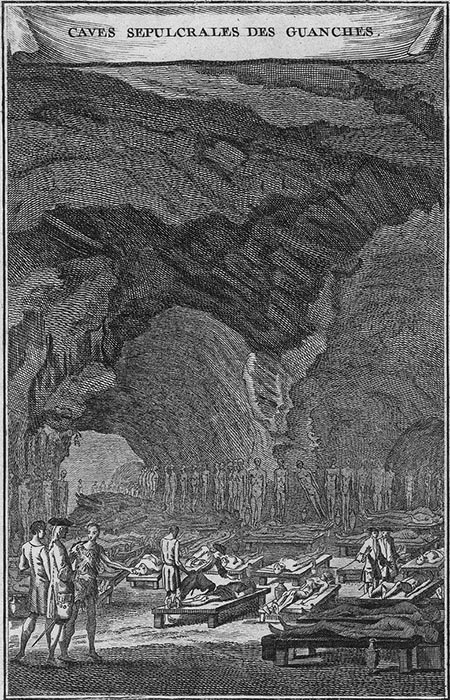
Representation of a Guanche burial cave in Harpe (1780).
I will focus on one specific case of this Egyptianized view of the mummification of Canary Islands. Several substances are mentioned during the description of the embalming procedures, but the use of salt does not appear in any text before the 18th century. At the beginning of the 16th century, Juan Abreu Galindo (ca. 1594-1602) wrote that certain specific parts of the corpses were washed everyday twice with cold water:"…y cada día los lavaban dos veces con agua fría las partes débiles, sobacos, tras las orejas, las ingles, entre los dedos, las narices, cuello y pulso." [An English version of this text was later published by the merchant George Glas (1764): "…then twice a day they washed the porous part of the body, viz. the arm-pits, behind the ears, the groin, between the fingers, and the neck, with cold water…"].
Abreu Galindo's text was later used and almost copied literally by Viera y Clavijo (1772), but he surprisingly added the salt as an ingredient. We found the explanation for this addition in another of his works, his Dictionary of Natural History. He defined the word 'natron' (a naturally occurring chemical salt) and explained that Herodotus wrote that the Egyptians used it for the embalming of their corpses. Because of this, he reasoned, perhaps the Guanches also used natron from Teide – the highest mountain of Tenerife – for the preservation of their mummies.

Mount Teide, Tenerife, Spain. (Wikimedia Commons)
Viera y Clavijo had no evidence that the aborigines used salt but supposed they did because of the information written by Herodotus.
Many authors directly or indirectly followed and copied his text. His supposition was rapidly widespread in an international context by the French naturalist Jean Baptiste Geneviève Marcellin Bory de Saint Vincent (1803). Consequently, salt as a substance used in Canary Islands' mummification became received wisdom and was included in many descriptions of later scholars – almost 20 have been attested. For example, 20th century Egyptologist Warren R. Dawson stated in 1927 that "…The washing of the interior of the body and the use of salt encountered among the Guanches are typically Egyptian…".
In spite of being an error introduced in the 18th century, based on analogy with the Egyptian mummification, the role of salt in mirlado can still be found even in 21st century publications. An in-depth comparative analysis of the transmitted information since the 15th century based on textual criticism has identified this and others mistakes, additions and reinterpretations, conscious or not, that compared the funerary practices of preservation of the deceased bodies in Egypt and Canary Islands. By removing these misconceptions, the local Canarian practices may now come into better view.
Daniel M. Méndez-Rodríguez is a lecturer at Escuela Universitaria de Turismo de Santa Cruz de Tenerife (Canary Islands, Spain). He is also deputy director of the Archaeological Mission of the Universidad de La Laguna for the study and restoration of TT 209 (Luxor, Egypt), and epigraphist of projects in Egypt.
For Further Reading:
Méndez-Rodríguez, D. M. (forthcoming): "The transmission of the descriptions about the mummification in the Canary Islands: between tradition and innovation", in: Athatatos. Extraordinary World Congress on Mummy Studies (Santa Cruz de Tenerife, May 21-25, 2018).
Méndez-Rodríguez, D. M. (forthcoming): "Canarian Mummies, Egyptian perspectives", in: Proceedings of the International Conference on Comparative Mummy Studies (Hildesheim, April 7-9, 2016).
Méndez-Rodríguez, D. M. (2018): "Egyptianizing Canary Islands mummies", Aula Orientalis. Revista de Estudios Del Próximo Oriente Antiguo, 38 (2): 277–296.
-- Sent from my Linux system.
No comments:
Post a Comment